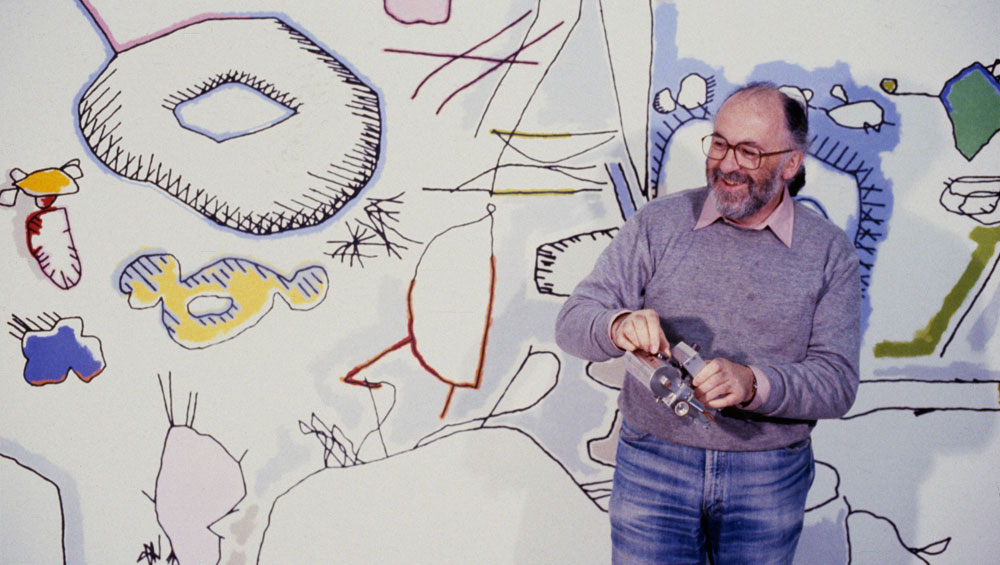
by CAROLINE MENEZES
“This is not another article about ‘computer art’.” With this sentence, Harold Cohen began his famous text, On purpose: an enquiry into the possible roles of the computer in art, in which he questioned whether machines could be used to serve artistic intentions. The essay was first published in the January 1974 issue of Studio International, with a cover designed by Cohen.1 This is also not an essay about computer art, but about an artist who has changed the way we now understand the interaction between art and technology. Cohen, who was born in London but had lived in the US since 1968, died last year on 28 April, at the age of 87. However, more important than the body of work he left us is the influence of his artistic practice on the manner in which contemporary artists deal with coding as a creative language.
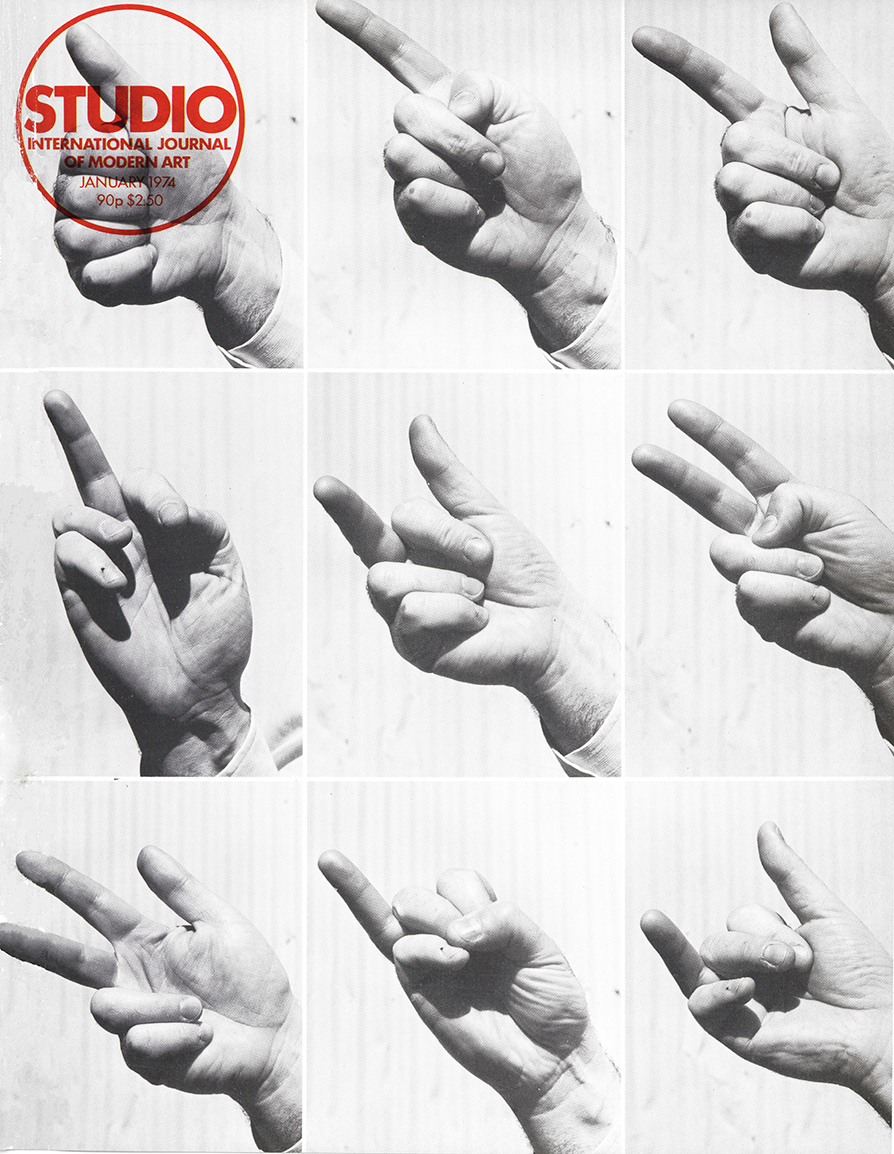
Cover, specially designed for Studio International, Vol 187, No 962, January 1974, by Harold Cohen.
Long before Cohen become a pioneer of computer art, he was already on the pages of Studio International. In June 1966, the magazine shone a spotlight on the nomination of the artists who would represent the UK at the 33rd Venice Biennale with two articles, Venice Biennale: the British five2 and Venice Biennale: choosing the artists.3 At the age of 38, Cohen, a painter with a well-established career, was one of those selected to take on the responsibility of “enhancing the prestige of Great Britain through the arts” and to show “the strength of British abstract art”, according to Studio International contributor Charles Spencer.3 In Venice Biennale: choosing the artists, Spencer explained that the British Council’s strategy when choosing the exhibitions’ lineup was not to take risks but rather to invite names with a recognised trajectory.
In this context, David Thompson, the author of Venice Biennale: the British five, differentiates Cohen's work as a gesture that develops intrinsically within his painting, with components that grow and group into a final image: “In a Harold Cohen painting there will be fragmentary linear movements and various areas of textured or flat colour where the tensions arise from the way they grow together – a dappled background intuitively suggesting the movement of line, line intuitively suggesting enclosed or partly enclosed shapes and colour areas – so that the results are both seemingly casual and organically close-knit: images, references, contradictions and possibilities are implicit at every stage – the inside of a line, for example, defining a shape; the outside of it apparently suggesting a spatial boundary; and the way it abruptly comes to an end leaving both interpretations open.”2
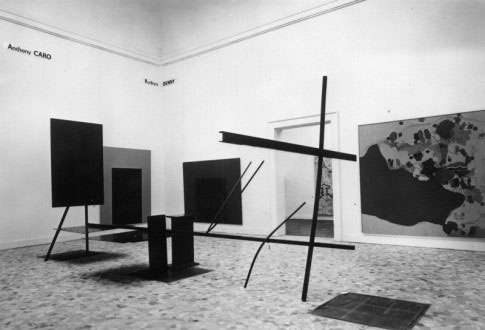
Detail of the British Pavilion at the 1966 Venice Biennial, showing Cohen’s painting on the right. Courtesy Harold Cohen’s archive.
The exhibition at the British pavilion, entitled Five Young British Artists, also featured the sculptor Anthony Caro, the painters Richard Smith and Robyn Denny, as well as another painter, Bernard Cohen, Harold’s younger brother. Although the main award did not go to the UK, the career of all five took off following the exhibition and they continued to gain international prestige, conquering museums and galleries.
Cohen, however, preferred to follow a more intricate path, radically changing his stance on art. Coincidentally, another of the interviewees featured in the same June 1966 issue of Studio International, Marcel Duchamp – in one of his last conversations published during his lifetime4 – had done a similar thing, abandoning painting in 1918 to follow a more cerebral artistic practice. Cohen, at the height of his career, with works in collections such as the Tate Gallery, likewise left everything behind.
Interviewed for the magazine by art critic Dore Ashton, Duchamp, when asked if he had anything to say about the extensive connection between art and technology and the efforts made by critics to make him the progenitor of this trend, replied: “They [the artists] have to get somebody as a progenitor so as not to look as though they invent it all by themselves. But art will be sunk or drowned by technology. […] Technology will surely drown us. The individual is disappearing rapidly. We’ll eventually be nothing but numbered ants.”4
Cohen did not submerge himself passively in technology. He dived in and explored the depths of the plots of the codes that compose it, visualising how to transform programming into creative expression. In 1968, he abandoned the London art scene to spend a season in the US that was initially to be a year long, but which lasted his whole life. The reason he packed his bags was an invitation to become a visiting professor at the Institute of Arts at the University of California, San Diego (UCSD). There he wrote his first computer program. According to the artist, the activity allowed him to use his brain in a completely new way. He recalled that it was a very exciting period when a small community was beginning to awaken to the extraordinary potential of computer coding.
He was surprised to realise how the thought he applied to his paintings resembled the way he interacted with the computer. For Cohen, his works contained standards that he instinctively followed while painting and, out of these norms, emerged a pictorial composition. Coding followed the same principle, but what fascinated Cohen was not writing instructions to see something made, but, rather, the fact that some of the instructions generated forms he had never imagined before. He first exhibited his computer artworks in 1972, at the Los Angeles County Museum of Art.
He was interested in the possibility of setting up commands that would enable the machine to make artistic decisions, as in the human creative process. Interviewed in 2015, he said: “My work at that time was neither abstract in a geometric sense nor was it figurative. It sort of hovered in a kind of space of evocation in which elements were present in a way that enabled the viewer to build meanings, compiling them into a single image. The question that lingered was: what was the minimum configuration of a set of marks that functions as a single image which appeals to the human vision? Therefore, the programme must have features that are very similar to the human cognitive system.”5
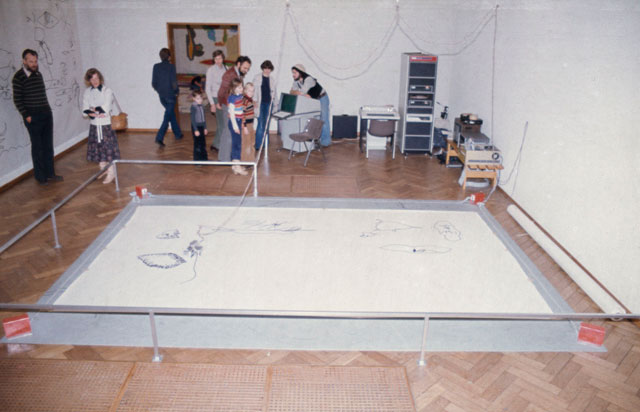
Harold Cohen’s Drawing Machine at the Stedelijk Museum, in Amsterdam, in 1977. Courtesy Harold Cohen’s archive.
In this phase, the artist who became a programmer also turned himself into an engineer and built a “drawing machine” to create works in real time inside exhibition spaces. The mechanical device performed a somewhat ambiguous action in relation to what Cohen wanted to reveal. The commotion that a computer operating within the museum (or gallery) caused among the audience distanced the experience from what really mattered: the programme simulating the human mind. He felt obliged to explain to the audience where the drawings actually came from. It was common to see the artist welcoming the visitors and talking with them about the process.
Around this time, Cohen was invited to become a visiting researcher at the Stanford University Artificial Intelligence Laboratory, which was a breakthrough for him. There, he gained access to the cutting-edge equipment used by the precursors of applied Artificial Intelligence, which allowed him finally to develop his research’s key issue: the machine’s feedback as a reflection of the artist – in other words, that precise moment when the painter is creating and suddenly stops, contemplates what he is doing, ponders and decides which direction to take. The result was Aaron, a program that the artist wrote in 1973, with its own identity, a name.
Cohen brought computational codes closer to the artistic process, so that the drawing’s last line would become a consequence of the first stroke on paper. However, the program did not have a visual system that would enable the “visualisation” of what was done. It evaluated the lines using calculations. In the museums and galleries that invited Cohen to put Aaron on display, the public watched the machine work at an intermittent pace. During the moments of pause, people wondered if the machine was thinking. In fact, it was going over its actions, computing the next step, always observing criteria implemented by Cohen and also the area of paper that still had to be filled.
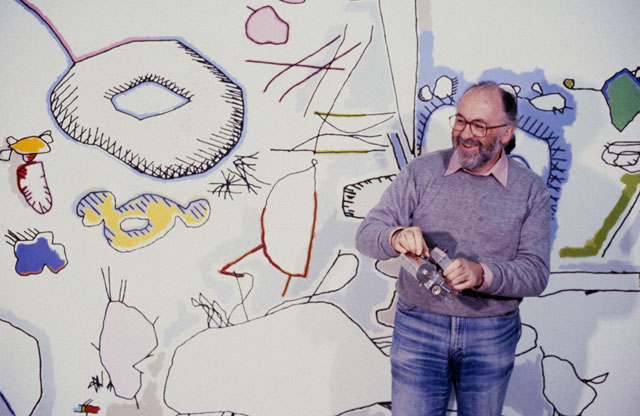
Harold Cohen holding a Turtle Robot at the San Francisco Museum of Modern Art, 1979 with a computer-generated, enlarged and hand-coloured temporary mural in the background. Courtesy Harold Cohen’s archive.
It was with Aaron and his drawing machine – that used an adaptation of a turtle robot in a more sophisticated version – that Cohen participated in Documenta 6 in Kassel, Germany, in 1977. He was subsequently invited to hold a solo exhibition in the same year at the temple of Dutch art, the Stedelijk Museum, in Amsterdam. He later retired the little robot because he thought it was too friendly and attracted more attention than the computer program.
In an attempt to create something akin to human cognition, Cohen spent the 1970s teaching the program more rules. However, he realised that, even with an increase in the outputs, the images generated (not just processed) did not become more complex. Cohen noticed that Aaron had stagnated. The programme was lacking something intrinsic to the development of human cognition: “I spent 10 years working on a programme that was being developed in a vacuum; it didn’t know anything about the outside world. So, it was time to take a step back and reveal the real world to the program.”5
What component of the “real world” did the artist first introduce to Aaron? Perhaps the first element that every human being perceives at birth: another human being. Like any draughtsman who dares to sketch a living model, Aaron took time to get the stroke right. In the case of portraits, it became apparent that the program had learned how to enhance a person’s representation. By the mid-80s, Aaron had sufficient spatial understanding to interpret three dimensions; therefore his figures had an interior scene as background.
It was also around this time that Cohen decided to teach Aaron to work with colours. Previously, the drawings were done by the drawing machine or printed on plotters, and Cohen would insert colour by hand. Teaching the program to colour was one of Cohen’s biggest challenges. He said: “There was no colour monitor when I started. So, there was no way to talk about colours with the machine. Later, the main problem was that my program was smart enough to do the drawings, but I had to come over and colour the drawing afterwards. The program does not have eyes, so it could not have the same visual feedback system that a human being colourist has. Instead of thinking about what it couldn’t do, I started to think about what it could do. And I suddenly realised that the computer can do something that human beings can’t. Once it makes marks in colour, it has an impeccable memory of what was there. The programme started to ‘colour adequately’.”5
Aaron went through several phases, just like any artistic entity. Cohen decided to compose the context of the human figures with some plants and flowers. Next, this flora grew, gained prominence, while people disappeared from the scene. Thus, the drawings became representations of nature. Later, the vegetation was no longer recognisable; the organic settings became non-figurative patterns. In a way, Cohen made the program go back to his origins, to the abstraction that distinguished him as a painter early on in his career. The artist believed that both painting and visual representation had an internal logic that did not appear on the surface of the plane, being anterior to what is seen on the canvas (or screen). In an unprecedented way, Cohen attained this veiled structure and deciphered the logic of painting through his coding.
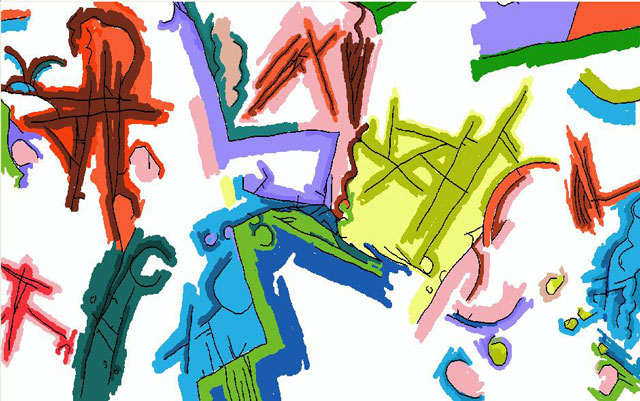
Harold Cohen. 141126.6, 2014. Pigment ink on canvas, computer generated image, 120 x 200 cm. Courtesy Harold Cohen’s archive.
In the last few years of his life, Cohen once again changed tactics. His relationship with Aaron would no longer be one similar to “creator and creature” – a creature who creates for the creator – but rather one of cooperation. For the exhibition Collaborations with My Other Self, at the UCSD gallery in 2011, he returned to the paints and brushes he had not touched for years. On that occasion, in addition to showing works totally done by his digital other self, Aaron, he made the program create patterns on only one plane so that he himself would once again paint on top. Cohen recalls that he had missed the tactile feeling of painting. He gradually solved this issue in an even more peculiar way by improving the program’s interface so that it could work on a touchscreen. Like a classical painter, he set up a 50-inch monitor as if using an easel and then chose colours with his fingertips to finalise the Aaron-generated drawing.
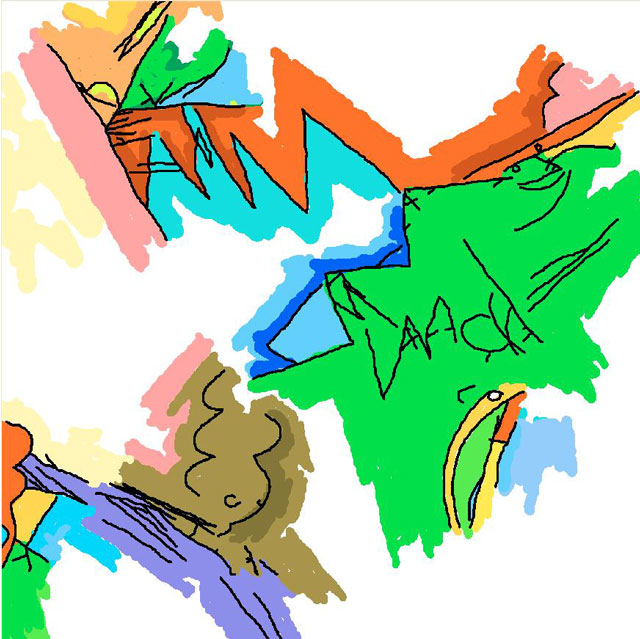
Harold Cohen. Wakl in Rio, 2015. Pigment ink on canvas, computer generated image, 120 x 120 cm. Courtesy Harold Cohen’s archive.
The works that resulted from this digital interaction were to be his last. A few days before Cohen’s death at home in Encinitas near San Diego last year, the pioneer artist was still performing the same activity he had been carrying out daily for 48 years: programming Aaron and creating art. Cohen once wondered if one day he could be the first artist to produce new artworks after his own death. It was meant to be a joke, but he soon realised how serious and delicate the idea was: “It would be nice if Aaron could tell me which of them [the images] it thinks I should print, but it can’t. It would be nice if it could figure out the implications of what it does so well and so reliably, and move on to new definitions, new art. But it can’t. Do those things indicate that Aaron has reached an absolute limit on what computers can do? I doubt it. They are things on my can’t-do-that list, and I’m aware I may never find a way of getting them off. But how can I know what insights tomorrow may bring?”6

Harold Cohen in his studio in the US, 2015. Photograph: Caroline Menezes.
The exhibition Primary Codes in 2015, at Oi Futuro Flamengo Cultural Centre in Rio de Janeiro, was the last major show in which Cohen participated intensely, presenting from earlier to new artworks and specially commissioned creations. In January 2017, UCSD University Art Gallery inaugurated a posthumous exhibition in his honour. Without any recent drawings, Aaron is no longer in operation.
References
1. On purpose: an enquiry into the possible roles of the computer in art by Harold Cohen, Studio International,Vol 187, No 962, January 1974, pages 11-16.
2. Venice Biennale: the British five by David Thompson, Studio International, Vol 171, No 878, June 1966, pages 233-38.
3. Venice Biennale: choosing the artists by Charles Spencer, Studio International, Vol 171, No 878, June 1966, pages 230-32.
4. An interview with Marcel Duchamp by Dore Ashton, Studio International, Vol 171, No 878, June 1966, 244-46.
5. Unpublished interview transcript of interview of Harold Cohen by Caroline Menezes and Fabrizio Poltronieri at Encinitas, US, on 6 and 7 May 2015. The exhibition Primary Codes in June 2015 at Oi Futuro Flamengo Cultural Centre in Rio de Janeiro
6. Aaron’s World by Harold Cohen. In: Harold Cohen: Aarons’ World, published by António Prates Arte Contemporânea, 2007, pages 3-7.